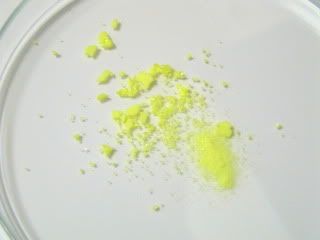I myself could not find any conclusive info on "molybdenum hydrate" and my textbooks only mention formation of a yellow precipitate on standing of an
acidified solution of ammonium paramolybdate, but they do not explain the real nature of this yellow material. I would expect it to be something like
MoO3.xH2O, but I'm not sure that this is yellow. Normally, MoO3 is white and its solutions and compounds and acids, derived from this, also are
white/colorless. |








 Here for example another
exotic compound:Tetramminezinc(II) Tetraperoxomolybdate(VI)
Here for example another
exotic compound:Tetramminezinc(II) Tetraperoxomolybdate(VI) .
.
 )
)

 oh my god...
oh my god...